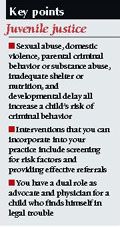Your patients in the juvenile justice system, and your role in their care and well-being
Are any of your patients headed for legal trouble? Can you do anything to alter their risk? The authors provide navigation through the juvenile justice system so that you can accomplish the most good.
DR. LIEBERMAN is associate chief for ambulatory pediatrics and director of the Adolescent Program at Albert Einstein Medical Center, Philadelphia, Pa.
MS. SIMKINS is an associate clinical professor and director of the Juvenile Rights Clinic at Rutgers-Camden School of Law, Camden, NJ.
The authors have nothing to disclose in regard to affiliations with, or financial interests in, any organization that may have an interest in any part of this article.
Risk factors
Major risk factors for behavior that can lead to involvement in the juvenile justice system include a learning disability or cognitive delay; a history of emotional, physical, and sexual abuse; neglect; trauma; mental disorders; and substance abuse.2-7 In fact, as many as one half of young persons in juvenile detention have a learning disability or cognitive delay, and as many as one third have been neglected or traumatized.
Minority race greatly increases the likelihood that a young person will be incarcerated.8 Although African-American and Hispanic children account for approximately 15% of the adolescent population, they account for approximately one half of young people in detention. This disparity appears to be independent of behavior: A comparison of psychiatric symptoms in young people in either juvenile detention or a psychiatric hospital found that race was the strongest predictor of placement, with minority youths more likely than white youths to be placed in a detention facility.9
"Shades of the prison house"-a time to recognize risk
Juvenile delinquency is an act by a person before his (her) 18th birthday that would be a crime if committed by an adult.10 A status offense is an act committed by a juvenile that would bring him to the attention of a juvenile court, but is not a criminal act; examples are running away from home, truancy, and violating a curfew.11 Your efforts can influence the course and outcome of a child's case during the pre-arrest, pretrial, trial, and post-trial and disposition stages, which are defined in the discussion that follows. (See "A snapshot of the juvenile justice system" for a comparison of the juvenile and adult justice systems.)

We define pre-arrest as beginning when you first recognize a red flag that a child is on the wrong path. Most pediatricians intuitively sense a patient's departure from the straight and narrow, and historical clues heighten a clinician's suspicion: Domestic violence, parental criminal behavior or substance abuse, and inadequate shelter or nutrition all increase a child's risk of criminal behavior later.2 Developmental delay arising from perinatal or genetic problems, and harsh and inconsistent parenting practices both are associated with juvenile delinquency.2 More red flags to look for as childhood progresses include fire-setting and cruelty to animals.12
Sexual abuse is an important risk factor for criminal behavior in girls and boys: A girl may place herself at risk of arrest through her attempt to escape the abuse-by running away and then prostitution, for example, to support herself. Studies demonstrate that more than half of incarcerated girls report having been sexually abused in childhood, and more than one third described symptoms of posttraumatic stress disorder (PTSD).5,13,14 Young males who have been sexually abused also have a higher risk of incarceration.15